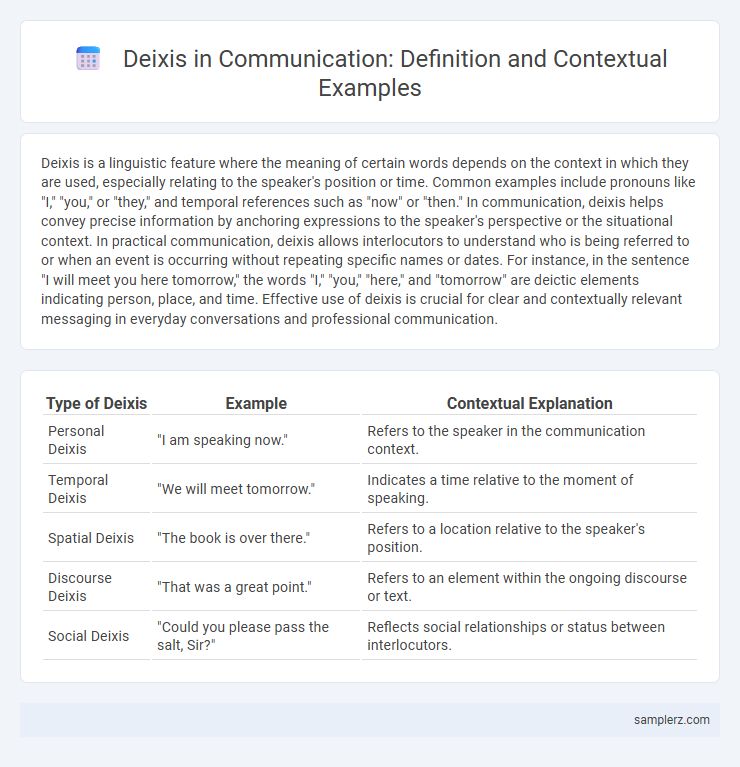Deixis is a linguistic feature where the meaning of certain words depends on the context in which they are used, especially relating to the speaker's position or time. Common examples include pronouns like "I," "you," or "they," and temporal references such as "now" or "then." In communication, deixis helps convey precise information by anchoring expressions to the speaker's perspective or the situational context. In practical communication, deixis allows interlocutors to understand who is being referred to or when an event is occurring without repeating specific names or dates. For instance, in the sentence "I will meet you here tomorrow," the words "I," "you," "here," and "tomorrow" are deictic elements indicating person, place, and time. Effective use of deixis is crucial for clear and contextually relevant messaging in everyday conversations and professional communication.
Table of Comparison
| Type of Deixis | Example | Contextual Explanation |
|---|---|---|
| Personal Deixis | "I am speaking now." | Refers to the speaker in the communication context. |
| Temporal Deixis | "We will meet tomorrow." | Indicates a time relative to the moment of speaking. |
| Spatial Deixis | "The book is over there." | Refers to a location relative to the speaker's position. |
| Discourse Deixis | "That was a great point." | Refers to an element within the ongoing discourse or text. |
| Social Deixis | "Could you please pass the salt, Sir?" | Reflects social relationships or status between interlocutors. |
Understanding Deixis in Communication
Deixis in communication involves words like "this," "that," "here," and "now," which rely on context to convey meaning. Understanding deixis is crucial for interpreting speaker intentions and situational references accurately. Effective communication depends on recognizing deixis to avoid misunderstandings in spatial, temporal, and personal contexts.
Types of Deixis and Their Functions
Deixis in communication includes person deixis, which refers to the participants involved such as "I," "you," and "they," anchoring the conversation around speaker, listener, and others. Place deixis uses spatial terms like "here," "there," and "over there" to indicate location relative to the speaker's position. Time deixis involves temporal expressions such as "now," "then," and "soon," situating events within a specific timeframe essential for coherence and context understanding.
Personal Deixis: Pronouns in Conversation
Personal deixis in communication often manifests through pronouns like "I," "you," and "we," which directly reference participants in a conversation. Pronouns shift meaning based on the speaker's perspective, making context essential for interpretation. Effective use of personal deixis enhances clarity in dialogues by explicitly indicating who is involved in actions or statements.
Spatial Deixis: Indicating Location
Spatial deixis in communication involves using words like "here," "there," "this," or "that" to indicate specific locations relative to the speaker and listener. For example, in the sentence "The book is over there," the word "there" directs attention to a place away from the speaker's current position. These deictic expressions help clarify spatial relationships, making communication more precise and contextually grounded.
Temporal Deixis: Referring to Time
Temporal deixis in communication involves referencing specific points or periods in time relative to the speaker's present moment. Phrases like "yesterday," "tomorrow," and "next week" illustrate temporal deixis by anchoring events to distinct temporal locations in a conversation. Understanding temporal deixis is crucial for interpreting the timing and sequencing of actions or events in discourse.
Social Deixis: Addressing Social Relationships
Social deixis in communication involves using language forms that reflect social relationships, such as titles, honorifics, and pronouns indicating respect or familiarity. For example, addressing someone as "Doctor Smith" versus "John" signals different social distances and levels of formality. This use of deixis helps manage social hierarchy and politeness within conversations.
Deictic Expressions in Everyday Speech
Deictic expressions such as "this," "that," "here," and "there" are fundamental in everyday speech, providing contextual clarity and grounding communication in shared spatial and temporal references. Pronouns like "I," "you," and "we" also function as person deixis, shifting meaning based on the speaker-listener relationship during interaction. Understanding deictic terms enhances effective communication by linking utterances directly to the immediate conversational context.
Deixis in Written and Spoken Contexts
Deixis in spoken communication often relies on immediate physical context, such as pointing gestures or temporal references like "now" and "here," to anchor meaning. In written contexts, deixis depends on linguistic cues and shared knowledge since physical context is absent, with examples including pronouns or text-based time markers like "yesterday" or "this page." Understanding these differences enhances clarity and precision in both oral and written discourse.
Challenges with Deictic References in Cross-Cultural Communication
Deictic references such as "this," "that," "here," and "there" often create misunderstandings in cross-cultural communication due to differing spatial and temporal perceptions. For instance, the pronoun "you" may imply varying levels of formality or respect in different languages, causing unintended offense. These challenges necessitate heightened awareness and clarification to ensure accurate message interpretation across cultures.
Enhancing Clarity Using Deixis in Communication
Deixis enhances clarity in communication by explicitly referencing time, place, and participants, such as using words like "here," "now," and "you" to anchor meaning within the context of the interaction. Precise deixis reduces ambiguity by situating statements relative to the speaker's perspective, thereby improving message comprehension in conversations and written texts. Effective use of deixis supports coherent discourse, ensuring listeners or readers correctly interpret spatial, temporal, and personal references.

example of deixis in context Infographic
 samplerz.com
samplerz.com